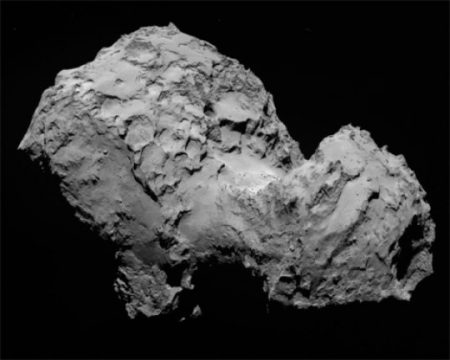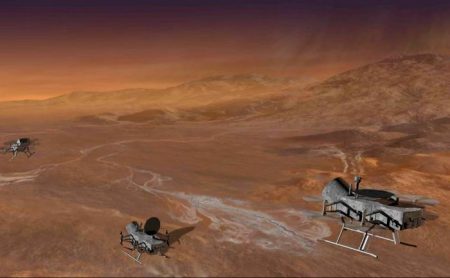December 20, 2017 – In the last hour, NASA has announced future Solar System missions to a comet and the moon Titan. In addition, the Agency has indicated it intends to develop technology for future missions to the moon Enceladus, and to the surface of Venus.
CAESAR to Revisit Comet 67P/Churyumov-Gerasimenko
The European Space Agency’s (ESA) Rosetta spacecraft rendezvoused with Comet 67P in 2014 and deployed a lander to its surface. Now NASA intends to follow up with CAESAR, the Comet Astrobiology Exploration Sample Return mission. The plan is to rendezvous with the comet and collect samples from it to return to Earth for analysis.
JAXA, the Japanese Space Agency, demonstrated a technique for sampling materials from a Solar System object and returning them to Earth in 2010 with its Hayabusa mission. Lasting seven years, Hayabusa was launched in 2003; rendezvoused with Near-Earth Asteroid Itokawa in 2005; deployed a small robot named Minerva to the surface; collected samples from several sites; and then returned the samples to Earth in 2010. NASA intends to use the demonstrated success of the Hayabusa mission in its design of CAESAR while using the incredible amount of data collected from the Rosetta mission to determine the best landing sites for sampling the comet’s nucleus.

Dragonfly to Follow Up Cassini-Huygens Mission by Delivering a Drone to Fly Through Titan’s Atmosphere
Our exposure to the fascinating world Titan is an important legacy of the Cassini-Huygens joint NASA and ESA mission that ended in September of this year. The Cassini orbiter with the companion Huygens lander was launched in 1997, arrived in the environs of Saturn in 2004, deployed the lander in early 2005, and mapped the moon’s surface over the next 13 years. We both know and don’t know Titan. It appears at first glance to be a colder version of Earth with rivers, lakes, and seas. Instead of the water cycle that drives the chemistry and biology of Earth, Titan has a hydrocarbon cycle with liquid methane a substitute for water. It is methane that flows on the surface, that forms the clouds in Titan’s sky, and that occasionally turns into rain. Cassini observed two rainstorms in its many years circling Saturn.
The Dragonfly mission, first proposed by a team from the Johns Hopkins Applied Physics Laboratory in Laurel, Maryland, proposed the advantages of creating a combination lander-flying robot capable of studying many Titan sites. The spacecraft that arrived at Saturn would release the dual-quadcopter robot which would visit many locations. Each flight could last up to one Earth hour moving tens of kilometers between sites. The plan would be to make one flight per Titan day (equivalent to 16 Earth days). The initial mission duration is set at approximately 2 years but if it is anything like the Mars rovers, Opportunity, and Curiosity, Dragonfly could zip around Titan for many years.
One of the big challenges is how Dragonfly will be powered. Solar is out with Titan’s so far from the Sun and a thick atmosphere that filters the light. Cassini was powered by a small nuclear reactor. Similar technology powers New Horizons, the Pluto probe. And Curiosity uses a radioisotope thermoelectric power pack to keep its instrumentation and motors that drive its wheels operating. This is the solution for Dragonfly as well. After daytime flights to new sites, the dual-quadcopter will then recharge during each Titan night (an 8 Earth day stretch).

Why Revisit Two Places in the Solar System We Have Already Visited?
Visiting a comet and acquiring a sample that can be returned to Earth will give scientists a chance to study a body that formed at the very beginning of our Solar System over 5 billion years ago. Comets originate in the Oort Cloud, beyond the Kuiper Belt of which the Pluto-Charon dwarf planet is a member. They are described as dirty snowballs and probably delivered the water that today is the predominant feature of our planet, the oceans of Earth. Bringing samples back from Churyumov-Gerasimenko, where Rosetta detected organic compounds could help answer the question, how did life begin on Earth?
Dragonfly isn’t a repeat of the Huygens lander. The proposed instrumentation will include mass spectrometers, gamma-ray spectrometers, meteorological and geophysics sensors, and cameras. With these tools, we will develop a detailed picture of Titan’s surface composition at many sites. We will measure the atmosphere and detect what is beneath the moon’s surface.
Astronomers believe under the surface of Titan lies an ocean of water greater than all the water on Earth. Dragonfly will turn belief into fact. And Dragonfly will also look at the complex hydrocarbons and chemistry of the moon, studying its organic chemistry to understand the prebiotic conditions that at one point may have been here on Earth before the emergence of life. It is even thought that beneath Titan’s surface, where water is present when combined with the hydrocarbons there as well, life might exist, described as “exotic methanogenic lifeforms.”
What Other Robotic Missions are Possible in the Next Decade?
Two other concepts will receive funding to develop the needed technology.
One is a mission to study Enceladus called ELSAH which stands for Enceladus Life Signatures and Habitability. ELSAH will fly through the plumes of water seen rising from Enceladus to measure the composition of the ocean that lies beneath the moon’s icy surface. Enceladus plumes contain organic compounds that could mean prebiotic or biotic conditions are in evidence.
The second is called VICI which is an acronym for Venus in situ Composition Investigations. VICI would be a lander capable of withstanding the hellish surface conditions of our planetary neighbour and would contain instrumentation capable of measuring surface composition.
All of the approved and pending missions are under the NASA New Frontiers Program focused on advancing planetary science, and first described in NASA’s 2014 Strategic Plan.







